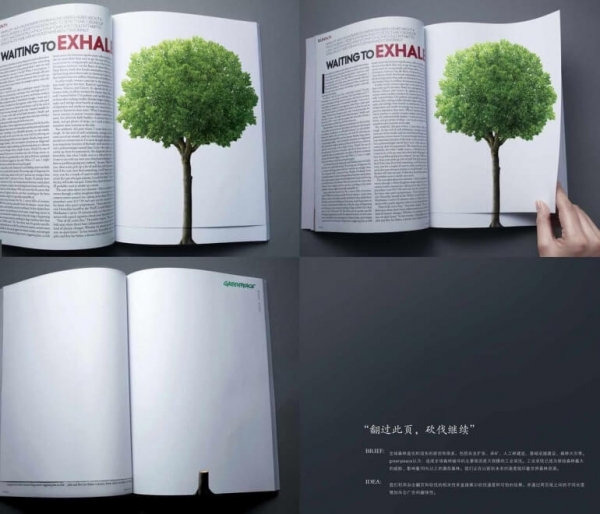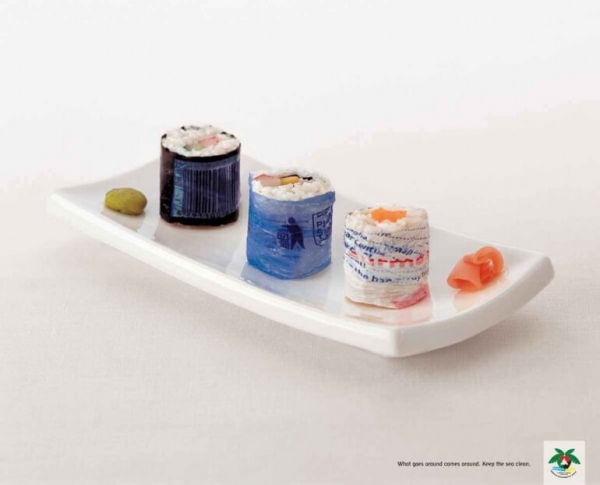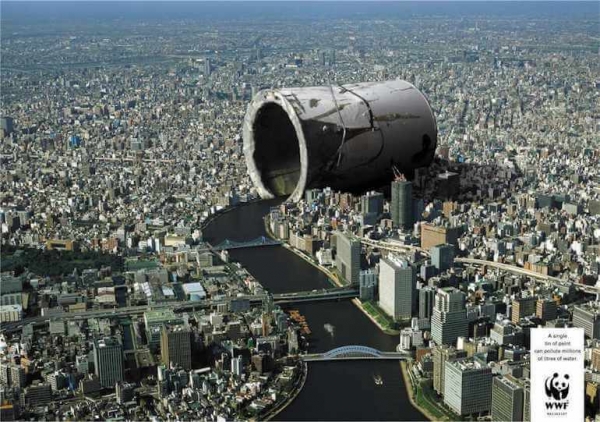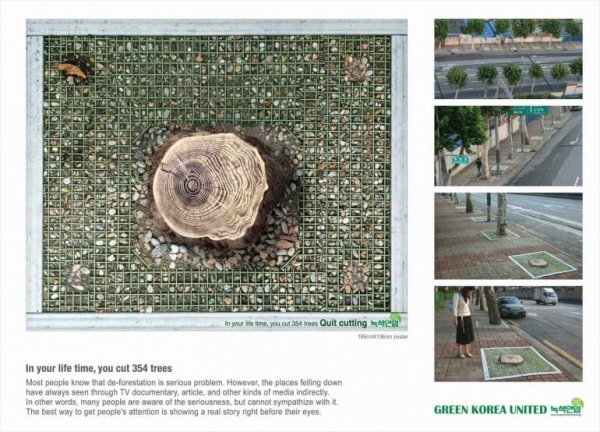We all have the responsibility to lead lives that aim to diminish the negative impact civilization has had on the environment. Of course the planet is going to be pretty much fine regardless of what we do. Many species however, including us, might not be.
Less is more has never been more true or more urgent. Opulence is something of the past while minimalism underlines the vital and inevitably translates into a lifestyle.
The sustainability preoccupation is ingrained in the design world which is already focused on recycling, optimizing production and using resources to their maximum potential.
There are some simple things that all of us can do, things like: don’t print, take short showers, bring your own bag to the store, don’t over-heat your home, use public transportation or ride your bike and think about getting a solar panel for your electricity needs.
In order to bring awareness to the damage done by the consumerism culture, creative and shocking environmental ads have been consistently used in cities around the world in anti-pollution and waste campaigns. Here are some of the most intriguing:
1. Horrifying
There’s little need for words in this brilliant WWF campaign about the frailty of ecosystems. The creators use space to create a feeling of solitude. The absence of life is the kind of apocalyptic scenario none of us wants to think about. What can be more frightening than destroying our own home and food supply?
Advertising Agency: DDB&CO., Istanbul, Turkey
2. Greenpeace: Tree.
Deforestation continues with the turn of a page.
Visualization is a powerful tool and this clever ad helps you realize that even if we don’t see it, the forests are suffering. This is one of those ads that remain relevant as the designers use blank spaces in a remarkable way to illustrate loss.
“BRIEF: The global degradation and disappearance of the world’s forests has many causes including agricultural expansion, mining, plantation construction, infrastructure construction and forest fires. Greenpeace believes that global deforestation is primarily due to large-scale industrial logging. Industrial logging has become the greatest danger to forests, threatening more than 70% of the world’s endangered forests. We are experiencing an unprecedented rate of destruction of the world’s forest resources.”
Advertising Agency: LINKSUS, Beijing, China
3. Bund- Brown bear
Hanging on to the time left until extinction, the image of desperation is haunting. The design team behind this had the brilliant idea to use the concept of time running out in a very literal and crude way. The result is not easy to look at but it’s sure to be memorable.
“Every 60 seconds a species dies out. Each minute counts. Each donation helps.”
Advertising Agency: Scholz & Friends, Berlin, Germany
4. Bee or not to be: Firing squad
5. Bee or not to be: air strike
These ads are characterized by crowding to symbolize a seemingly unstoppable attack.
One of the most relevant issues at the moment is the extended loss of bee colonies all over the world for various reasons; many losses can be explained by the use of chemicals but some could not as the damages of pollution affect bees in ways that we don’t even fully understand.
“The death of bees is a silent war. The decline of pollinators will cause devastating impacts on the environment and on food production. Get informed. Protect them.”
Advertising Agency: 6P Propaganda & Marketing, Ribeirão Preto, Brazil
6.Nabu- Wolf
This sensitive design touches on the transience of wildlife in Europe: a glorious wolf leaving the picture, part of him already gone. Many European countries have lost all or most of their wolves to excessive hunting and development and sadly when they disappear they leave behind an imbalanced ecosystem.
“Almost gone: the wolf. With your help it will stay (…)”
Advertising Agency: BUTTER. Berlin/Duesseldorf, Germany
7. Nylon bags
So much waste goes into the ocean that we have floating islands of garbage and many sea creatures think it’s food. We have yet to find a way to dispose of all the garbage we produce, so the only solution is to consume and therefore throw away less. The clean image of a sushi plate suggests how everybody wants to live, but some things cannot be concealed and waste makes its way onto the plate.
“What goes around comes around. Keep the sea clean.”
Advertising Agency: JWT, Dubai, UAE
8. WWF: Lungs
This beautiful image brings awareness to the damage of deforestation and it shows the forest as a living organism. There is a two part message here: for me it is a message of hope, of beauty and life, but it’s also a call to act now before it’s too late.
“Before it’s too late.”
Advertising Agency: TBWA\PARIS, France
9. WWF river pollution: Paint
Water pollution is wonderfully illustrated in this awareness ad. Only 3% of all water is drinkable and now it is becoming scarce even in the most civilized parts of the world. Many people don’t understand that even throwing away cooking oil contaminates a large quantity of water.
“A single tin of paint can pollute millions of liters of water.”
image
Advertising Agency: Contrapunto, Madrid, Spain
10. Green Korea United: Hand
The rise of the sea level means the disappearance of many iconic places like London, Bangkok and Seoul. This ad from South Korea shows how it feels to be close to disaster.
“We are drowning. Rescue us from global warming.”
Advertising Agency: Daehong Communications, Seoul, S.Korea
11. WWF Desertification: Leopard
Another great global warming awareness ad comes from WWF and it looks at the other end of global warming: desertification.
“Desertification destroys 6.000 species every year.”
Advertising Agency: Contrapunto BBDO, Madrid, Spain
12. City of Toronto Livegreen: Treebike
Toronto’s Live Green program aims to promote clean air, reduce pollution and encourage citizens to bike. The image used shows how something simple like riding your bike to work makes a difference in how much CO2 there is in the air we breath.
“Resources. Tips. Rebates. At Livegreentoronto.ca.”
Advertising Agency: Agency59, Canada
13. WWF: Tree
Images speak louder than words as this inspiring ad proves once more. Ironically, the tree cutters are resting in the shade of the one tree they didn’t cut.
“Forests for life”
Advertising Agency: Ogilvy & Mather, Bangkok, Thailand
14. Green Korea United: Quit cutting
What’s wonderful about this unique idea is that it helps the public visualize the magnitude of the issue and because of the ad’s location it serves as a strong reminder. A number is just a number, but a tree stump and the knowledge that one’s lifestyle has caused 354 similar tree stumps certainly is thought-provoking.
“In your lifetime, you cut 354 trees.”
Advertising Agency: Daehong Communications, Seoul, S.Korea
15. Bank of the Planet: Garbage
We’ve already touched the waste management dilemma, but this poignant piece of design displays it from another angle: a small planet formed entirely from non-degradable garbage. There is no out, it all stays here.
“There is no out”
Bank of the Planet. Investments generating information and actions.
Advertising Agency: Neogama/BBH, São Paulo, Brazil
16. PRASA (Paper Recycling Association of South Africa): Paper Forest
I left the best for last. Great visuals, great text and great advice:
“1 tree produces 8500 sheets of paper.
8500 sheets of paper don’t produce oxygen, shade, home or food.
All the more reason to use paper wisely and recycle.”
Advertising Agency: TBWA\Hunt\Lascaris Cape Town, South Africa
What goes into the making of a successful environmental ad? It all starts with a clear concept and keeping it simple. Most effectively, these ads allow empty spaces to convey deep meaning and let viewers contemplate. Minimalism is often the recipe for success with strong images and a strong line of text. Some of them are not pleasant or easy to look at because the point is to bring awareness to unpleasant awful things. And there are some which are beautiful, albeit saddening.
Oops, did we miss a really creative environmental ad? Probably. Let us know in the comments and also let us know what you do everyday to waste less.




















کارتن سازی
June 13, 2020Protecting the environment is the duty of all of us, and it would be very interesting and effective to recommend this important work with a work of art